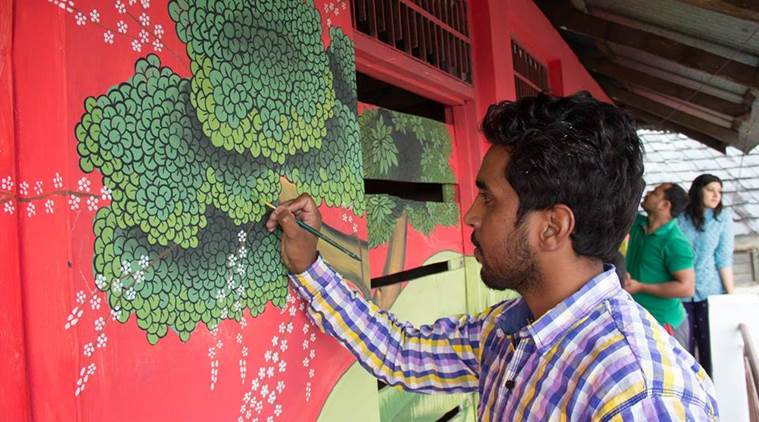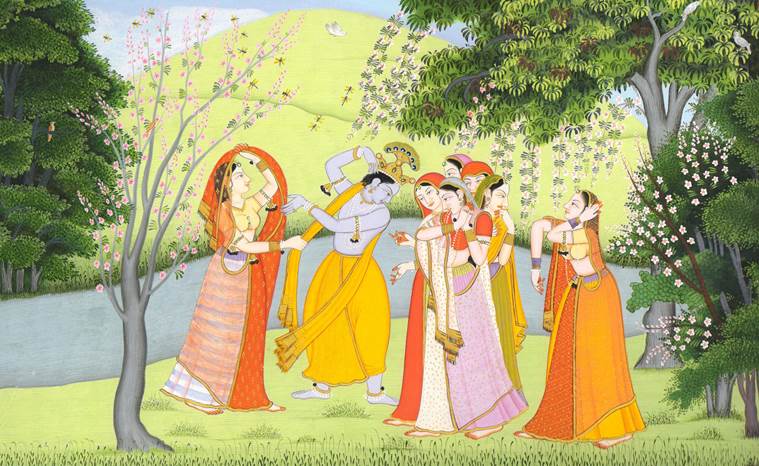Written by Pooja Pillai |New Delhi |Updated: January 20, 2019 6:00:57 am
How the 300-year-old Kangra school of art is getting a fresh lease of life
On the walls of Kangra Arts Promotion Society's gallery in McLeodganj, an airy space with windows offering stunning views of the valley below, are exquisite paintings in the 300-year-old Kangra painting tradition.

In McLeodganj, along the road from the main square to the Dalai Lama temple are souvenir shops and trinket stalls. There may once have been a time when these businesses sold tchotchkes that were unique to the region, but, over the years, most of their wares have acquired a pan-national character. The macrame wall hangings, papier-mâché boxes, chunky jewellery and cheap T-shirts you find on the streets of McLeodganj, are as much at home here as they are on the pavements along Colaba Causeway or the Wednesday flea market near Anjuna beach. In the chaos of modern commerce, objects harking back to centuries-old tradition can be hard to sell, and yet, this is precisely the task that the Kangra Arts Promotion Society (KAPS), an NGO, has been quietly working at for the last decade. On the walls of its gallery in McLeodganj, an airy space with windows offering stunning views of the valley below, are exquisite paintings in the 300-year-old Kangra painting tradition.
Monu Kumar, 37, who works at the gallery, is one of half-a-dozen artists who have been trained by KAPS in the Kangra painting tradition and are currently working as full-time painters. Set up in 2008 by IAS officer BK Agarwal, who was then the divisional commissioner of Kangra and is currently chief secretary to the Himachal Pradesh government, the society was meant to boost what was then a floundering art form. “An art lover himself, he got others, including some well-to-do locals and NRIs, to establish the society with the idea of training artists in this art form,” says Varun Singh, secretary of KAPS. The society’s first move was to run a competition to identify local artists who could be trained in the tradition. The selected artists underwent a year-long course, besides being paid a monthly stipend and provided access to master artists and materials.

Kangra painting, like most traditional art forms, demands rigour and discipline. Its characteristic delicate lines on sheets of handmade wasli paper can only be drawn using squirrel hair brushes. The paper and the brush, which were once made by the artists themselves, now have to be brought from Rajasthan. The paper is pressed and primed for days and the paints are ground by hand from raw minerals — also acquired from Rajasthan — in heavy stone pestles. These are processes that go back centuries, and predate the late 17th to early 18th century exodus of artists from the Mughal court and their arrival in the tiny Himalayan states of Guler, Chamba, Nurpur, Kangra, Garhwal and Basohli, where they flourished and created the Pahari school of painting.
Kumar says, the techniques and materials remain unchanged. “Most of the time, the subject matters are age-old ones which continue to be favourites among art collectors and patrons,” says Kumar. So just like the painters in the court of Maharaja Sansar Chand Katoch (1776-1824), a Krishna bhakt and one of the patrons of Kangra painting, the artists working with KAPS continue to depict the life and amorous adventures of the blue-hued God, taking episodes from Bhagavata Purana and Jaidev’s Gita Govinda. The artists are also, however, being encouraged to explore other themes. Kumar shows images of a painting depicting the celebration of Rali Mela, which was commissioned by the state government and presented as a gift to President Ram Nath Kovind.
“I was inclined towards painting since I was a child. After completing school, I got interested in thangka (Tibetan Buddhist scroll painting) for a while. When I heard about the competition by KAPS, I decided to apply,” says Kumar, who’s been with the society for 10 years. Besides being a full-time artist, he looks after the gallery. Most artists are encouraged to work independently even as they continue to make paintings that are sold by KAPS. “Earlier, when we were giving the artists a monthly stipend, we noticed that the quality was not improving. So we decided to grade the paintings based on quality, and the pricing began to be based on the grade. The grading is done by master artist Mukesh Kumar of the Chamunda Devi Temple,” says Singh. The society still supplies all materials. Every month, when artists submit their works for sale, they receive 40 per cent of the price before sale, with the remaining amount coming through once the painting is sold.
“It is important that the paintings sell and that the artists are able to make a living. But this work can’t be sustained by selling paintings. We get commissions from the state government, but we need to look at productizing,” says Singh. The high standards will still be a priority. “Since everything is handmade, it has a certain price range. The Kangra painting has become a symbol of the region. It has a market and we’re playing a small role in ensuring that it expands, ” says Singh.
This article appeared in print with the headline ‘The Revivalists: The Kangra school of art, a 300-year-old tradition, gets a fresh lease of life’.






















No hay comentarios:
Publicar un comentario